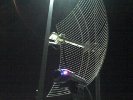What are they? Fiber links are optical ethernet (100base-FX) connections that port to/from CAT5 ethernet (100base-TX/RJ45) connections. Recently, a number of the D-Link DFE-855 transducers became available used. D-Link list price is just under $180 (two required to work). Here is the blurb:
The D-Link DFE-855 is a Fast Ethernet media converter that translates transmission signals from a twisted-pair 100BASE-TX cable to 100BASE-FX fiber optic cable. It expands network data transmission distances beyond the 100 meter limitation of copper wire to a maximum of two kilometers by using fiber optic cable in full duplex.
The DFE-855 provides auto-sensing detection of full duplex or half duplex signaling. It has easy-to-read diagnostic LED´s for continuous status reports on network speed, duplex media access control connection, and network traffic. The DFE-855 uses standard RJ-45 UTP/STP and SC fiber optic connectors and is IEEE 802.3u 100BASE-TX/FX compliant and operates with all devices that adhere to this standard.
These come with a 5vdc, 1.5a brick that uses a standard 120v IEC computer wall cord. They need an SC/SC 62.5/125 dual mode Duplex optical cable set between them.
They don't do MDIX so you have to connect one to either the crossover port of a hub, an autosensing switch or use a true crossover cable to connect one directly to a computer. This is because both devices are MDI when one should be either auto-sensing or MDIX. You can join two routers directly since nearly all do autosensing.
Testing Testing them is simple. Connect a CAT5 jumper from your router to one transducer/power brick set. Connect your laptop to either a crossover cable or a switch-then to the other device pair. You must connect the TX port of one device to the RX port of the other. Example: Red in TX, Black in RX on the sending end, Black in TX, Red in RX on the receiving end.
Open a cmd or shell window and ping your gateway. I was able to leave the router end connected and cycle through all of the other devices w/o relinking the DHCP address. This is because the router "saw" the first optical device and gave it an address during the first test. Between tests, there is no link but the DHCP remained. I ran a dfw.speakeasy.net speed test on the pair and saw exactly the same speed as hard wired to the router.
What are they good for? In high RF environments and where there is risk of lightning, ground loops or power surges, optical is the industry standard for separating one network from another. The optical run can also be up to 2km so they are frequently used for long distance links. You can run a CAT5 jumper to a transducer, a number of feet of fiber and another CAT5 jumper on the other end to totally isolate RF and electrical interaction between two lan segments.
We are currently investigating alternate (read cheap) sources of fiber that will work with these devices. Weed trimmer stock has been mentioned by some.



